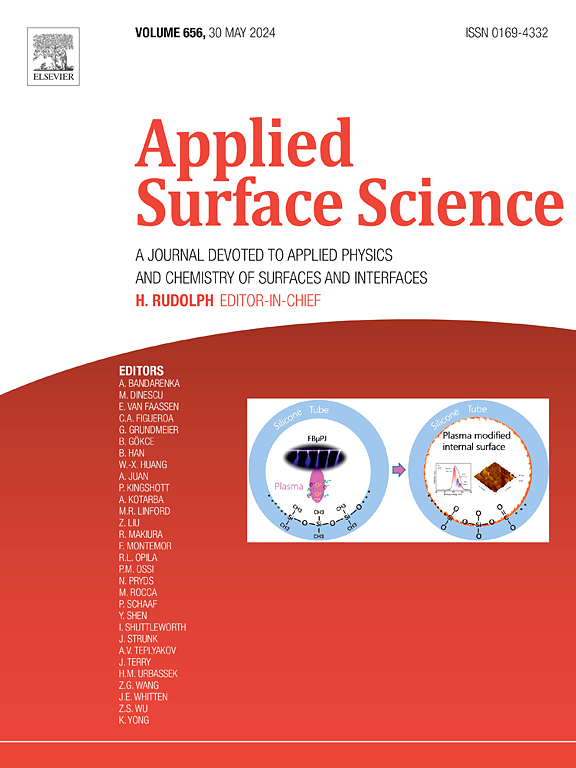通过激光辅助矿化在牙本质基质上构建抗菌晶体双层:表征和功能意义
IF 6.3
2区 材料科学
Q2 CHEMISTRY, PHYSICAL
引用次数: 0
摘要
形成羟基磷灰石(Ca10(PO4)6(OH)2;含不同浓度抗菌剂的聚羟基磷灰石多层膜可以帮助控制牙周组织中各种细菌的感染。然而,从临床角度来看,快速(在几分钟内)和简单地在牙齿上构建这种多层膜尚未实现。如果实现,这种技术可以通过促进感染控制来促进口腔健康。本研究在牙本质上快速构建了含有不同浓度抗菌剂(Ag和F)的结晶双分子层。这是通过将预涂有Ag(NH3) 2f的吸光膏的牙本质底物置于假生理磷酸钙溶液中30秒激光照射来实现的。透射电子显微镜和能量色散x射线能谱分析表明,辐照基底的上层由F-HAP (F-HAP)棒状结构组成。棒材层中Ag (<50 nm)的含量为0.14 ± 0.03 at.%。下层由颗粒状F-HAP和CaF2组成,Ag (<50 nm)含量为0.49 ± 0.17 at.%。x射线光电子能谱测量表明,Ag在辐照基底表面有两种化学状态:Ag0(对应Ag粒子)和Agδ+(取代F-HAP晶体中的Ca2+离子)。该双层膜对变形链球菌具有抗菌活性,在抗菌牙科治疗中具有广阔的应用前景。本文章由计算机程序翻译,如有差异,请以英文原文为准。

Antibacterial crystalline bilayers constructed on dentin substrates via laser-assisted mineralization: characterization and functional implications
The formation of hydroxyapatite (Ca10(PO4)6(OH)2; HAP)-based multilayers containing antibacterial agents at different concentrations on teeth can help control infections against various bacteria in periodontal tissue. However, from a clinical perspective, rapid (within minutes) and simple construction of such multilayers on teeth has not yet been achieved. If realized, such a technique could contribute to oral health by promoting infection control. In this study, crystalline bilayers containing antibacterial agents (Ag and F) at different concentrations were rapidly constructed on dentin. This was achieved by subjecting the dentin substrates precoated with Ag(NH3)2F-containing light-absorbing paste to 30-s laser irradiation in a pseudo-physiological calcium phosphate solution. Transmission electron microscopy and energy-dispersive X-ray spectroscopy analyses revealed that the upper layer on the irradiated substrate was composed of F-substituted HAP (F-HAP) rods elongated to the c-axis. The content of Ag (<50 nm in size) in the rods layer was 0.14 ± 0.03 at.%. The lower layer was composed of particulate F-HAP and CaF2, with the Ag (<50 nm) content of 0.49 ± 0.17 at.%. X-ray photoelectron spectroscopy measurements indicated two chemical states of Ag on the irradiated substrate surface: Ag0, corresponding to Ag particles, and Agδ+, which substituted Ca2+ ions in the F-HAP crystals. The bilayers exhibited antibacterial activity against Streptococcus mutans, highlighting their potential for application in antibacterial dental treatment.
求助全文
通过发布文献求助,成功后即可免费获取论文全文。
去求助
来源期刊

Applied Surface Science
工程技术-材料科学:膜
CiteScore
12.50
自引率
7.50%
发文量
3393
审稿时长
67 days
期刊介绍:
Applied Surface Science covers topics contributing to a better understanding of surfaces, interfaces, nanostructures and their applications. The journal is concerned with scientific research on the atomic and molecular level of material properties determined with specific surface analytical techniques and/or computational methods, as well as the processing of such structures.
 求助内容:
求助内容: 应助结果提醒方式:
应助结果提醒方式:


